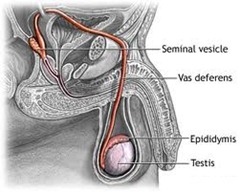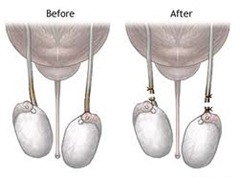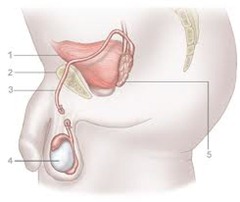A vasectomy is a simple, safe, 15 minute procedure done under local anesthesia in the doctor’s office that can prevent unwanted pregnancies and the problems associated with pregnancy. I had a sign in my office that said, “If you had a vasectomy you never have to say, “I’m sorry.” Thousands of vasectomies later it’s still true. No more condoms. No more pills. No worries.
Vasectomy anatomy:
(Click pictures to enlarge) The vas deferentia are tubes that arise from each testis and travel up to the back of the prostate and enter into the prostate along with fluid from the seminal vesicles. That fluid along with secretions from the prostate is called semen. When you “come”, that is, have an orgasm, that is the fluid is ejaculated. Only 1% of the total volume of semen is actually sperm. So after a vasectomy you do not see or feel a difference in your semen volume.
A vasectomy is the snipping and removal of a one inch piece of the vas deferens with interruption of the tubes that carry sperm from their production site in the testes, and to the outside (the outside is your partner’s inside).
You have a vasectomy because you, not your wife, but you, no longer want to father additional children.
The operation is permanent so if you are not absolutely certain that you do not want to father children again don’t do it. I will be writing another blog in the future about vasectomy reversal.
If you are considering banking you semen, “just in case,” don’t have a vasectomy.
But if you have decided that more children are not what you want it is a great operation and you should do it. There is no downside to the operation.
The other function of the testis is to produce the male hormone testosterone. That hormone enters the body through the blood vessels that drain the testes, not through the vas deferens. The bottom line: there is no effect of male hormone production after vasectomy.
Vasectomy, what you have to consider? A few points:
-
In New York State, by law, there is a mandatory one month waiting period from the time you are counseled and sign your consent, to when you can have the procedure. For other states check with your urologist.
-
We are really doing a “partial vasectomy”. The vas deferens is about 2 feet long and we are removing an inch, so it’s ‘partial’, not ‘complete’. For this reason, it takes about 13 ejaculations to rid the vas deferens of remaining sperm. You should not consider yourself infertile until your semen is checked under a microscope to look for remaining sperm. If the sample shows no sperm, you are given the good to go sign.
-
You can return to work the next day after vasectomy surgery.
Frequently asked questions about vasectomy:
-
Is there a lot of pain after vasectomy?
After vasectomy surgery there tends to be an ache in the groin for a few days until the wounds heal as the testes pull down on the vasectomy site.
-
Are there possible complications of vasectomy?
All surgeries can have complications of bleeding and infection, but the chance of that happening is only a few percent, but not 0%, so it is possible. If that problem occurs it takes a few weeks longer to feel 100%, but the complication does not affect the vasectomy results, and you will still be sterile.
-
Does sex feel any different after vasectomy?
Sex feels exactly the same physically after vasectomy. Mentally, sex can actually be more enjoyable because you no longer have to worry whether the condom will break or your wife or girlfriend did not take precautions.
“No-scalpel vasectomy” or “Incisionless vasectomy”
Some doctors claim and market that they do incision-less vasectomy surgery. That is not possible. The vas deferens lies under the skin and although the incision is only a ¼ of an inch, you need to open the skin to reach the vas deferens. The opening is closed with one or two stitches that dissolve so they do not have to be removed.



